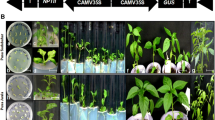Abstract
A reliable Agrobacterium tumefaciens-mediated transformation method has been developed for peas (Pisum sativum) using immature cotyledons as the explant source. Transgenic plants were recovered from the four cultivars tested: Bolero, Trounce, Bohatyr and Huka. The method takes approximately 7 months from explant to seed-bearing primary regenerant. The binary vector used carried genes for kanamycin and phosphinothricin resistance. Transformed pea plants were selected on 10 mg/l phosphinothricin. The nptII and bar genes were shown to be stably inherited through the first sexual generation of transformed plants. Expression of the phosphinothricin-resistance gene in the transformed plants was demonstrated using the ‘Buster’ (=‘Basta’) leaf-paint test and the phosphinothricin acetyl transferase enzyme assay.
Similar content being viewed by others
Abbreviations
- BA:
-
6-benzylaminopurine
References
An G, Ebert PR, Mitra A, Ha SB (1988) In: Gelvin SB, Schilperoot RA, Verma DPS (eds) Plant Molecular Biology Manual, Kluwer Academic Publishers, Dordrecht pp. A3/1-A3/19
Christou P (1994) Euphytica 74:165–185
Colby SM, Juncosa AM, Meredith CP (1991) J Am Soc Hort Sci 116(2):356–361
Crampton NJ (1975) NZ J of Agric 131:11–183
Davies DR, Hamilton J, Mullineaux P (1993) Plant Cell Rep 12:180–183
Gamborg OL, Miller RA, Ojima K (1968) Exp Cell Res 50:151–158
Goulden DS, Scott RE (1993) NZ J of Crop and Hort Sci 21:265–266
Grant JE, Brown AHD, Grace JP (1984) Aust J Bot 32:665–677
Jacobsen H-J (1993) Grain Legumes 2:12–13
Lazo GR, Stein PA, Ludwig RA (1991) Bio/Technology 9:963–967
Puonti-Kaerlas J, Eriksson T, Engström P (1990) Theor Appl Genet 80:246–252
Puonti-Kaerlas J, Eriksson T, Engström P (1992) Theor Appl Genet 84:443–450
Schroeder HE, Schotz AH, Wardley-Richardson T, Spencer D, Higgins TJV (1993) Plant Physiol 101:751–757
Timmerman GM, Frew TJ, Miller AL, Weeden MF, Jermyn WA (1993) Theor Appl Genet 85:609–615
Author information
Authors and Affiliations
Additional information
Communicated by E. D. Earle
Rights and permissions
About this article
Cite this article
Grant, J.E., Cooper, P.A., McAra, A.E. et al. Transformation of peas (Pisum sativum L.) using immature cotyledons. Plant Cell Reports 15, 254–258 (1995). https://doi.org/10.1007/BF00193730
Received:
Revised:
Published:
Issue Date:
DOI: https://doi.org/10.1007/BF00193730




